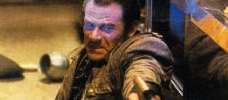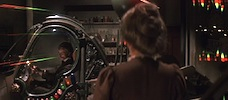Reviews
Jeannot Szwarc
USA, 1980
Credits
Review by Ellen Lindner
Posted on 23 August 2010
Source Universal DVD
Categories Favorites: Time Travel
Somewhere in Time tells the story of Richard Collier (Christopher Reeve, just two years after Superman), a young man just beginning his career as a playwright. As the film opens, we hear the audience for his debut play babbling happily as Collier stands surrounded by well-wishers. The Altmanesque jumble of voices continues as the camera brings us into the shadows, where we see a small, veiled figure sitting alone. Wearing a dark, antiquated dress, her gray hair in a style that stopped being à la mode seven decades before, this audience member couldn’t be more different from the college students in a huddle around Collier. Undeterred, she approaches the budding playwright and presses a gift upon him: a pocket watch. “Come back to me”, she cries, on the verge of tears, and leaves. Collier can’t understand what she means—he’s never met her before in his life.
We next meet Richard Collier eight years later. We can see from his high-rise Chicago office, the rows of framed Playbills bearing his name and his quietly elegant clothes that he’s become a success. In the midst of preparing his newest opus, he suddenly decides to take a break and spend a weekend at the Grand Hotel, a gorgeous white balustraded building stretching in a stately way along the shore of Lake Huron. The hotel - a relic of the Gilded Age a century before - is itself a kind of time machine, harking back to an era when domestic resorts like Newport (or, in this case, Mackinac Island) had a unique, exclusive glamor.
The problem is, Collier can’t figure out what he’s doing there. After all, he’s of a different generation than much of the clientele, and the amusements on hand - walking by the lake and waiting for dinner to be served - don’t suit his high-energy personality. Bored stiff, Collier explores the History Room of the hotel and discovers that it houses an extraordinary photograph: a portrait of the early 20th century actress Elise McKenna.
This is where things get freaky. We watch as Collier becomes convinced that this portrait of McKenna - a superlative beauty, played by Jane Seymour - has a special meaning for him. As the film unfolds and Collier learns more about this hauntingly beautiful siren of yore, he realizes that he needs to meet her. This desire seems futile when he discovers that McKenna died eight years earlier—on the very evening she came to see his first play. Undeterred, Collier explores a method of time travel requiring no DeLorean, no Tardis, and no knowledge of the higher physics: good old self-hypnosis.
The would-be time traveller finds inspiration in a book that McKenna read and re-read during the decades she spent in seclusion—a book written, fortuitously enough, by an old professor of our hero’s. Having traveled back in time himself, albeit only for an instant, the older man has a warning for Collier. Is it wise to give up your entire life, he asks - your future, your real past, and perhaps even your sanity - for what may only be an illusion?
After all, when Collier finally arrives in 1912 - waking up to a domestic argument in the room that would be his, seventy years in the future - it all seems so real. The food, the clothes, even the little boy bouncing a ball in the hotel lobby, who’ll grow up to be Collier’s porter—every detail is perfect, except for Collier’s suit. “I haven’t seen a suit like that in ten years!” a French actress in McKenna’s troupe exclaims, giving us a hint of what’s to come. Collier’s gotten so much right—but when you’re from another time, another place, there’s always something you never thought to reflect upon, one niggling detail you ignored completely.
Say what you will about its no-frills, DIY approach to time travel, Somewhere in Time boasts an indisputably great cast. This humble reviewer only knows Christopher Reeve from the Superman films and an incredibly dodgy made-for-TV remake of Rear Window, featuring a post-paralysis Reeve in the Jimmy Stewart role. In Somewhere in Time, Reeve’s imposing physique and air of intelligence make it seem plausible that his character could pull off a solo mission into the past—he still has that Superman gleam about him. Furthermore, it’s frankly not very hard to believe that two such colossally hot people as himself and Ms. Seymour just might spend all eternity lusting after each other—in fact, it may be the leads’ shared magnetism that gives the film its appeal.
Perhaps that tells you all that you need to know about time travel, and its importance to the plot of Somewhere in Time. After all, the film doesn’t revolve around grandfather paradoxes or butterfly effects. The world won’t implode because of Collier’s terribly off-trend suit, or his ball game with someone he’d know almost a century in the future. Somewhere in Time, does however, raise the question of whether or not time travel is actually worth it. Can you really get to know someone from another century? This extends not just to the lovers’ courtship, which begins with a string of miscommunications, but also to Collier’s relationship with William Fawcett Robinson, Elise’s manager and personal watchdog. The awkwardness which marks the exchanges between Collier and Robinson - who is just as much a man of his time as Collier is of his - comes from the fact that the two men have not only different agendas but completely different frames of reference. A typically stilted example:
ROBINSON:
Where are you from, Collier?COLLIER:
Chicago. Where are you from, sir?ROBINSON:
I’m given to understand that you’re a playwright.COLLIER:
You understand correctly.ROBINSON:
No doubt you dream of seeing Miss McKenna in one of your opera—that’s plural for opus. I assume you’ve written more than one?COLLIER:
Mmmm-hmmm! And seen them produced.ROBINSON:
Really? I’m not entirely unacquainted with the achievements of the American stage in the last decade… perhaps I’ve seen one?COLLIER:
No, I doubt it.ROBINSON:
I also doubt very much that I shall ever see one—graced by Miss McKenna.COLLIER:
You don’t really believe that’s why I’m here, do you?
And so on. It’s tempting to come up with a viable means of traveling through time just so you can enter this fictional dimension, tap Robinson on the shoulder and whisper, “don’t bother, dude—HE’S FROM THE FUTURE!”
Collier gets much further with the lovely Miss McKenna, despite the fact that they, too, barely speak the same language. And yet, true to the time travel genre as a whole, the tenuous connection between past and present always poses special dangers. Collier’s professor warned him that he had to be in an old place, surrounded by old things, if he was to make a successful attempt to voyage in time. But it still comes as a devastating shock when after an amazing, candle-extinguishing night of early twentieth century bliss, Collier discovers the only thing that can destroy his chances at happiness: a shiny new 1979 penny.
With a gorgeous score by John Barry, a script by Richard Matheson from his own novel, and a peerless cast and setting, Somewhere in Time elegantly exemplifies a tiny sliver of a sentimental sub-category of the time travel genre—films exploring the exquisite ennui of crossing the space time continuum in search of a hot date. This isn’t, after all, a film in which a character goes back in time to re-evaluate past decisions, a la Peggy Sue Got Married. The narrative to which Somewhere in Time seems to owe the most, in fact, comes from the world of prose fiction, namely Daphne du Maurier’s The House on the Strand, in which the main character experiences the sensation of time travel through experimentation with hallucinogenic drugs. The crucial difference is that, in du Maurier’s thriller, the time traveller can’t actually influence events in the past, his body still being in the present—du Maurier’s hero only travels with his mind, whereas for Richard Collier the mind is only the beginning. When a participant in the House on the Strand experiment dies, run over by a train while his brain is somewhere in 1325, the event introduces a level of jeopardy to the narrative which doesn’t threaten the players in Somewhere in Time. But as the ending of Somewhere in Time proves, physical danger is nothing compared to the harm we can inflict on our own minds.
More Favorites: Time Travel
-

Bill and Ted’s Excellent Adventure
1989 -

Trancers
1985 -

The Time Machine
1960 -

Groundhog Day
1993 -

Warlock
1989 -

The Navigator
1988 -

Tomorrow I’ll Wake Up and Scald Myself with Tea
1977 -

The Spirit of ‘76
1990 -

Flight of the Navigator
1986 -

La jetée
1962 -

Twelve Monkeys
1995 -

Beastmaster 2: Through the Portal of Time
1991 -

Peggy Sue Got Married
1986 -

Time After Time
1979 -

Somewhere in Time
1980 -

Back to the Future
1985 -

Back to the Future Part II
1989 -

Back to the Future Part III
1990 -

Idaho Transfer
1973 -

Unidentified Flying Oddball
1979 -

Slaughterhouse-Five
1972 -

The Lake House
2006 -

Time Bandits
1981 -

Doctor Who
1963–present -

Doctor Who
1963–present
We don’t do comments anymore, but you may contact us here or find us on Twitter or Facebook.



